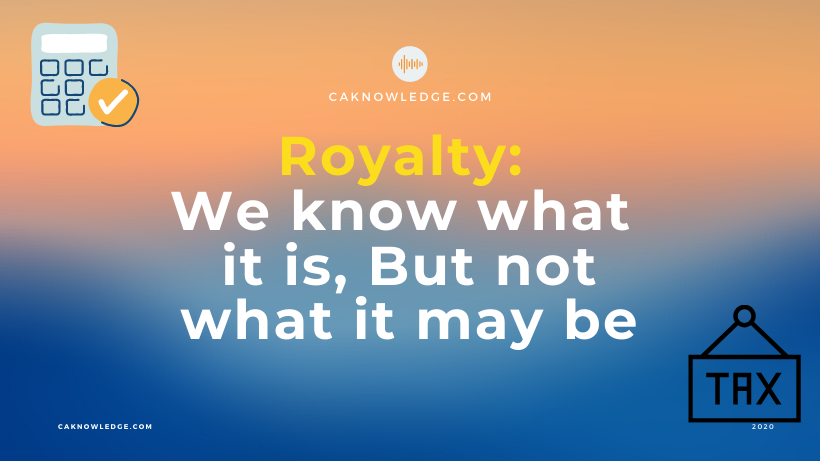This article is an endeavour to make its readers understand that ‘Royalty on minerals’ does not attract GST in all cases. There has been various articles/resources/AAR doing rounds on the internet that make these ‘Royalty’ transactions taxable, based on which the tax payer takes a decision to pay tax under Reverse Charge Mechanism (‘RCM’).
Apparently, what they fail to consider is the facts of the case that is prevalent in their company with that of the facts that has been stated in the article/resources/ AAR. So, it would be correct to say, “Misery acquaints a man with strange bedfellows” – William Shakespeare [Tempest]
Now, before diving into the topic and putting forward my views on these transactions, we take two scenarios:
Scenario 1: M/s XYZ Limited is in the business of mining and exploring minerals and supplies the same to the prospective customers and pays royalty at specified rates to the respective State mines departments.
Advertisement
Content in this Article
Scenario 2: M/s XYZ Limited is in the business of construction of roads and bridges. It employs various contractors to construct road and bridges at an agreed value. The contractors use the minerals in the execution of the project that has been awarded and raises the RA Bills upon completion of each milestone.
Royalty
When the RA Bill is presented for payment, M/s XYZ Limited deducts 3% (say) from the bill in the name of royalty due to non-presentation of e-challan by the contractor and deposits the same to the State mines department, as per instruction received from the State mines department so as to prevent revenue leakage of the State ex-chequer since the contractor has not paid royalty on the minerals that has been used in the execution of the project.
In the above two scenarios, it would be quite evident as to what is the subtle difference between the two. In both the scenarios, Royalty is being paid but the payer is different.
- Scenario 1: Payer – The person who is into the business of mining and actually uses the minerals – The actual user
- Scenario 2: Payer – The entity that has awarded the contract to the contractor – Not an actual user
So, RCM is applicable in both the scenario. But, its payer would be different:
- Scenario 1: Payer – The person who is into the business of mining and actually uses the minerals – The actual service recipient.
- Scenario 2: Payer – The contractor who has actually procured and used the minerals – The actual service recipient.
How did we reach to this conclusion? For ease of understanding, we take the rules of one State Government say, The State of Bihar and analyse what it says about royalty and its payment.
As per sub-rule (1) of Rule 57 of the Bihar Minerals (Concession, Prevention of Illegal Mining, Transportation and Storage) Rules, 2019 read as:
“When a Mineral Concession is granted:-
- (a) …………………;
- (b) Royalty shall be charged at the rates specified in Schedule III (A); and
- (c) ……………………………..
And, as per sub-rule (4) of Rule 57 of the Bihar Minerals (Concession, Prevention of Illegal Mining, Transportation and Storage) Rules, 2019 read as:
‘Notwithstanding anything contained in any instrument of lease the Mineral Concession Holder shall pay rent/royalty in respect of any minor mineral own, extracted and removed at the rate specified from time to time in Schedule II and III(A).’
Now as per clause (xvii) of Rule 2 of the rules ‘Mineral Concession Holder/ Settlee/Lessee’ is defined to “means a person(as defined in these rules) holding a valid Mineral Concession for quarrying/raising stone, sand and other minor minerals from the settled/ lease hold area and would also include the plural there of”
Now as per clause (xvii) of Rule 2 of the rules ‘Mineral Concession’ is defined as “means a mining lease or settlement in respect of minor minerals and includes quarrying permits, permitting the mining of minor mineral(s) in accordance with the provisions of these rules”
If we read the above provision as mentioned in the rules as laid down above, it could be construed that the person who is liable to pay the royalty is the mineral concession holder.
On liability to pay tax in GST:
As per GST law, any service provided by the State Government to any business entity is liable to reverse charge mechanism (Sl. No. 5 of Notification No. 13/2017 – Central Tax (Rate) dated 28.06.2017).
Herein, the definition of recipient of service is to be noted. As per clause (93) of section 2 of the CGST Act, 2017 recipient of service means –
- a) Where a consideration is payable for the supply of goods or services or both, the person who is liable to pay that consideration.
Herein, the person who is liable to pay the consideration (i,e Royalty) is the mineral concession holder and the liability to pay tax under RCM is casted upon that person as that person/ contractor is engaged in the activity of the mining and procurement of minerals.
In Scenario 2, the payment of 3% is also a payment of royalty by the contractor to the state mines department and accordingly RCM shall be applicable in the hands of the contractor and not in the hands of the entity i.e M/s XYZ Limited
Conclusion:
Thus, in scenario 2, the mines department has shifted the liability to pay Royalty on the entity due to non-presentation of e-challan by the contractor. It might be an argument that since, since no e-challan is presented the responsibility to pay royalty is now on M/s XYZ and thus RCM shall be applicable in such cases.

